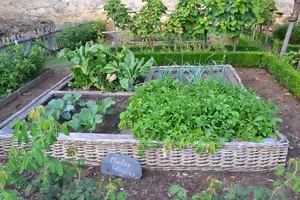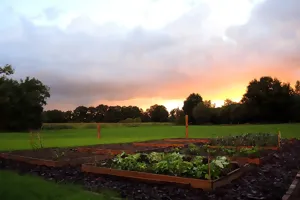You always had the dream to be able to harvest your own vegetables fresh from the garden? Then you should definitely plant a vegetable garden. We have summarized here for you what you should pay attention to so that it works out with the rich harvest.

Contents
How much space do you actually need?
At the beginning there is the question of how large the kitchen garden should be? Do you want to be completely self-sufficient from the vegetable garden? Do you want to grow potatoes, cabbage and other space-intensive vegetables or just snack vegetables like some lettuce, a few tomato plants and some aromatic herb plants? In most cases, the main priority for amateur gardeners today is the pleasure of growing and harvesting their own vegetables, rather than self-sufficiency, because nowadays you can buy fresh vegetables almost all year round everywhere.
Generally speaking, to partially supply a family of four, you can get by with a bed area of 120 to 160 square meters, which is about 30 to 40 square meters per person. Some vegetable species require a relatively large amount of space, while others are quite modest in their space requirements – the less space available for the vegetable bed, the more carefully you should plan and assess which species are really worthwhile.
More difficult to decide is what quantities to grow to ensure a basic supply and how much space is needed for this – here, of course, some questions arise: how many fruits does a tomato plant bear, for example? And how long can you harvest from a zucchini plant before it is exhausted? How quickly do you plant too much and end up with a crop glut!
To give you an approximate orientation, we have compiled the average yields of vegetables per square meter once in the table below – use this table to make a list of all the vegetables you want to grow, then it will be clearer to you how much space you need at least for this.
Possible fruit yields per square meter (with optimal care)
- Culture yield/sqm
- Lettuce 10 – 14 pieces
- radish 12 – 16 pieces
- bush beans 1,5 – 1,8 kg
- Tomatoes 7 – 10 kg
- cucumbers 2 – 3 kg
- celeriac 4 – 6 kg
- peppers 2 – 3 kg
- carrots 4 – 5 kg
- beet 4 – 5 kg
- runner beans 2 – 3 kg
- Onions 3 – 4 kg
In addition to the question of the size of the garden, there is also the question of how much time you can spare for its maintenance. As a rule, vegetables need even more attention than ornamental plants – you need to water, hoe, weed, fertilize several times a year, as well as watch out for diseases and pests, and not just once in a while, but practically every day, because only well-maintained vegetables promise a rich harvest. And in the end, harvesting and processing the vegetables also cause work.

This is the right place for a vegetable garden
Most vegetables need plenty of sun to thrive, shade retards growth, encourages fungal infections and slows fruit ripening – so the sunniest location is the best for a vegetable garden.
On the other hand, exposed, windy locations and the proximity of a busy road should be avoided. Completely windless locations, such as beds enclosed by walls and hedges, are also not ideal, because here the moisture evaporates more slowly and the plants remain wet longer after a rain, which can promote the spread of diseases. In addition, part of the beds would be in the shade, and in early spring the cold air is slow to leave, forming so-called cold traps and cold air lakes, which cause a delay in the development of plants.
The ideal place for the vegetable garden is sunny and airy, but not windy. It is also important that there are no large trees in the immediate vicinity, they would deprive the vegetable plants of light, air, water and nutrients.
This is the right soil
Almost all vegetables thrive in good, normal garden soil. Normal, good soil is when it is sandy-loamy, well-drained soil that can hold water and also nutrients well.
The soil should also have sufficient humus content to allow a rich microflora and fauna to form. These tiny soil creatures, barely visible to the naked eye, are indispensable for a living, fertile soil because they release organic matter and convert it into nutrients that can only be absorbed by plants in this form. If you have many earthworms in your garden soil, this is already a good sign.
Waterlogged and heavily compacted soils are not suitable for vegetable gardens and must be improved by digging and adding sand and humus.
Every vegetable garden begins with a plan
Once the above points are done and the soil is prepared, you can finally start laying out the vegetable patch. To do this, you should first draw a floor plan of the vegetable garden to scale. This way, you can first plan “on the drawing board” and make any necessary changes.
Rectangular beds are easy to maintain and make the best use of the available space, they should have a width of 1 to 1.2 meters. If they are too wide, it is difficult to reach the center of the bed during maintenance work. The length, on the other hand, is arbitrary and depends, among other things, on what crops are planned. Herbs need much less space than the various vegetables, so herb beds naturally turn out smaller than vegetable beds.
It all depends on the division
If there is enough space, it is recommended to divide the vegetable garden into four plots of equal size. This type of division has a long tradition in cottage gardens and is not only beautiful to look at, but also really useful, because in this way you will optimally meet the needs of each type of vegetable.
1st plot: heavy growers (e.g. potatoes, leeks, peppers, cucurbits, cabbages, celery)
2nd plot: medium growers (e.g. carrots, beets, onions, radishes)
3rd plot: low-growers (e.g. herbs, beans, peas, radishes, lettuces, onion plants)
4th plot: permanent crops (e.g. asparagus, rhubarb and vegetables that can grow in the same place over and over again e.g. tomatoes).
In each subsequent year, the vegetables grown move one plot further: thus, the medium growers move to the bed previously occupied by the strong growers, the weak growers follow the medium growers, and the strong growers move to the plot previously occupied by the weak growers – but only after it has been improved with compost or rotted manure and fertilized with an organic vegetable fertilizer!
When planning, take your cue from the main crops with a long standing time, such as head cabbages, celeriac and runner beans. The fast-growing crops such as leaf lettuce, spinach, radish, kohlrabi, etc. are planted with the main crops, and you should always follow the recommendations for mixed culture, as it contributes significantly to plant health.
Sowing and planting in the vegetable garden
For vegetables, the choice is between self-growing by sowing seeds and buying pre-pulled seedlings – seeds you can get in specialized stores practically all year round, seedlings are usually offered only for a few weeks in the spring at the peak planting season. In our online store you will find everything you need for sowing or planting.

